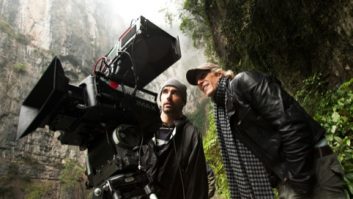
In interview: IMAX EMEA General Manager, theatre development, Julian Stanford talks to TVBEurope about fast frame rates, audio for 3D and the IMAX conversion process. TVB: There are calls to project films at faster frame rates. Peter Jackson is shooting The Hobbit at 48fps, for example. What is your view of the benefits of faster fps projection and what investment it would take to make it possible? JS: IMAX has been experimenting with 48fps since the early 1970’s and we actually still have some film projectors capable of playing 48fps. Back then, several films were made for IMAX at 48fps and the imagery was stunning. Implementing 48fps in digital is a not without issues as related to implementation. Given that IMAX uses a dual projector solution (also pictured), we are better suited to support higher frame rates as related to 3D – higher frame rates can only be achieved through the use of dual projectors. We have been developing software tools that allow us to convert standard shot 24fps content into 48fps content and we continue to work on this technology. We have found that not every scene necessarily requires use of a higher frame rate. Scenes with fast motion tend to benefit the most. While the use of 48fps is a creative decision made by the director, there are some who feel that the increased temporal resolution obtained through higher frame rates can give the content a TV or live action type of look. IMAX is working to incorporate higher frame rate capabilities into future systems; however the server manufacturers must also enhance their capability to operate at substantially higher bandwidths for data flow as required for higher frame rates. I do not expect to see higher frame rates hit the market anytime soon, however, IMAX does intend to remain at the leading edge of technology development.
Could you explain the 2D-3D conversion process which IMAX offers? JS: IMAX has developed a proprietary 2D to 3D conversion process and successfully applied to select sequences in five film projects: Space Station 3D (2002), Superman Returns (2006), Harry Potter and the Order of Phoenix (2007), Happy Potter and the half-blood Prince (2009) and Hubble 3D (2010). All the conversion projects listed were performed by an IMAX team located in Toronto, Canada. The conversion process comprises the following steps:
- Perform DMR processing on each shot of the 2D movie to be converted. (DMR is IMAX’s proprietary Digital Media Remastering).
- Create a 3D plan for each shot, which include decisions on depth, foreground objects and background objects.
- Separate each object in a shot and this process is often referred to as rotoscoping.
- Build a depth model for each object that has been separated.
- Compute depth maps from the depth models.
- Render stereoscopic 3D views based on the depth maps.
- Adjust and approve the rendered stereoscopic 3D views.
- Fill in the missing information in the rendered stereoscopic 3D views.
- Approve the final 3D views.
- The IMAX 2D to 3D conversion is very much about artistry vs. pushing the data through a standardized routine process. It’s complicated and not something we do frequently, but when we do, we do it the right way.
What input does IMAX provide to the 3net TV channel launched with Discovery and Sony? JS: We provide strategic advice and content to our partners. So far, 3net has slated IMAX 3D documentary titles including Hubble 3D, Under the Sea 3D, Deep Sea 3D, Magnificent Desolation: Walking on the Moon 3D, Into the Deep, and Galapagos.We’re excited to extend our business relationship with Sony and Discovery and like being on the ground floor of this innovative opportunity,” says Stanford. What advances is IMAX making in terms of the audio experience in its theatres for 3D movies? JS: IMAX sound systems are designed from the ground-up, specifically for the venues to which they are used in – no other system in the world can claim this level of customisation. Our proprietary loudspeakers are designed using PPS technology to ensure that every seat within the theatre is a good listening position. Our theatres are acoustically treated to IMAX’s demanding performance standards to ensure the best audio imagery. We offer 10 times the dynamic range as compared to other digital systems. IMAX is the only company that works with the studio and film maker to completely remix the soundtrack for the IMAX venue. This remix allows the filmmaker to take full advantage of the performance enhancements of the IMAX sound system which otherwise, could not be achieved in regular digital theatres. IMAX does not employ a 5.1 or 7.1 audio track as found in conventional systems, rather we remix separate, uncompressed and discrete soundtrack for each channel; this allows the filmmaker to pinpoint the origin of sound much more accurately that conventional sound systems thereby making the experience more realistic – hearing a soundtrack in IMAX is like being there when it was recorded. Our nXos sound system employs a patent pending technology that uses microphones permanently located throughout the theatre which collect audio data and forward it to our proprietary audio enhancer that ensures that the sound does not degrade. Should the system discover an anomaly it sends an alert to IMAX technical Services and makes audio adjustments as required. Standard cinema exhibitors are finding a market for alternative content – such as the live transmission of sports in 3D. How can IMAX exploit this market? JS: It is our intention to be able to project live events on IMAX screens at some time in the future. The production values of current 2D and 3D live events are inconsistent and typically we would want to be able to enhance the quality in some way, so we are monitoring progress in this area and will enter into the live market when it makes the most sense. There are 528 IMAX theatres worldwide today of which 435 are 3D. Over 100 digital systems were installed last year and we expect that number to continue for 2011 year and into 2012. Julian Stanford is a speaker at 3D Masters 2011 www.3d-tvmasters.com/www.imax.comIn interview: IMAX EMEA General Manager, theatre development, Julian Stanford talks to TVBEurope about fast frame rates, audio for 3D and the IMAX conversion process. TVB: There are calls to project films at faster frame rates. Peter Jackson is shooting The Hobbit at 48fps, for example. What is your view of the benefits of faster fps projection and what investment it would take to make it possible? JS: IMAX has been experimenting with 48fps since the early 1970’s and we actually still have some film projectors capable of playing 48fps. Back then, several films were made for IMAX at 48fps and the imagery was stunning. Implementing 48fps in digital is a not without issues as related to implementation. Given that IMAX uses a dual projector solution (also pictured), we are better suited to support higher frame rates as related to 3D – higher frame rates can only be achieved through the use of dual projectors. We have been developing software tools that allow us to convert standard shot 24fps content into 48fps content and we continue to work on this technology. We have found that not every scene necessarily requires use of a higher frame rate. Scenes with fast motion tend to benefit the most. While the use of 48fps is a creative decision made by the director, there are some who feel that the increased temporal resolution obtained through higher frame rates can give the content a TV or live action type of look. IMAX is working to incorporate higher frame rate capabilities into future systems; however the server manufacturers must also enhance their capability to operate at substantially higher bandwidths for data flow as required for higher frame rates. I do not expect to see higher frame rates hit the market anytime soon, however, IMAX does intend to remain at the leading edge of technology development.
Could you explain the 2D-3D conversion process which IMAX offers? JS: IMAX has developed a proprietary 2D to 3D conversion process and successfully applied to select sequences in five film projects: Space Station 3D (2002), Superman Returns (2006), Harry Potter and the Order of Phoenix (2007), Happy Potter and the half-blood Prince (2009) and Hubble 3D (2010). All the conversion projects listed were performed by an IMAX team located in Toronto, Canada. The conversion process comprises the following steps:
- Perform DMR processing on each shot of the 2D movie to be converted. (DMR is IMAX’s proprietary Digital Media Remastering).
- Create a 3D plan for each shot, which include decisions on depth, foreground objects and background objects.
- Separate each object in a shot and this process is often referred to as rotoscoping.
- Build a depth model for each object that has been separated.
- Compute depth maps from the depth models.
- Render stereoscopic 3D views based on the depth maps.
- Adjust and approve the rendered stereoscopic 3D views.
- Fill in the missing information in the rendered stereoscopic 3D views.
- Approve the final 3D views.
- The IMAX 2D to 3D conversion is very much about artistry vs. pushing the data through a standardized routine process. It’s complicated and not something we do frequently, but when we do, we do it the right way.
What input does IMAX provide to the 3net TV channel launched with Discovery and Sony? JS: We provide strategic advice and content to our partners. So far, 3net has slated IMAX 3D documentary titles including Hubble 3D, Under the Sea 3D, Deep Sea 3D, Magnificent Desolation: Walking on the Moon 3D, Into the Deep, and Galapagos.We’re excited to extend our business relationship with Sony and Discovery and like being on the ground floor of this innovative opportunity,” says Stanford. What advances is IMAX making in terms of the audio experience in its theatres for 3D movies? JS: IMAX sound systems are designed from the ground-up, specifically for the venues to which they are used in – no other system in the world can claim this level of customisation. Our proprietary loudspeakers are designed using PPS technology to ensure that every seat within the theatre is a good listening position. Our theatres are acoustically treated to IMAX’s demanding performance standards to ensure the best audio imagery. We offer 10 times the dynamic range as compared to other digital systems. IMAX is the only company that works with the studio and film maker to completely remix the soundtrack for the IMAX venue. This remix allows the filmmaker to take full advantage of the performance enhancements of the IMAX sound system which otherwise, could not be achieved in regular digital theatres. IMAX does not employ a 5.1 or 7.1 audio track as found in conventional systems, rather we remix separate, uncompressed and discrete soundtrack for each channel; this allows the filmmaker to pinpoint the origin of sound much more accurately that conventional sound systems thereby making the experience more realistic – hearing a soundtrack in IMAX is like being there when it was recorded. Our nXos sound system employs a patent pending technology that uses microphones permanently located throughout the theatre which collect audio data and forward it to our proprietary audio enhancer that ensures that the sound does not degrade. Should the system discover an anomaly it sends an alert to IMAX technical Services and makes audio adjustments as required. Standard cinema exhibitors are finding a market for alternative content – such as the live transmission of sports in 3D. How can IMAX exploit this market? JS: It is our intention to be able to project live events on IMAX screens at some time in the future. The production values of current 2D and 3D live events are inconsistent and typically we would want to be able to enhance the quality in some way, so we are monitoring progress in this area and will enter into the live market when it makes the most sense. There are 528 IMAX theatres worldwide today of which 435 are 3D. Over 100 digital systems were installed last year and we expect that number to continue for 2011 year and into 2012. Julian Stanford is a speaker at 3D Masters 2011 www.3d-tvmasters.com/www.imax.com







